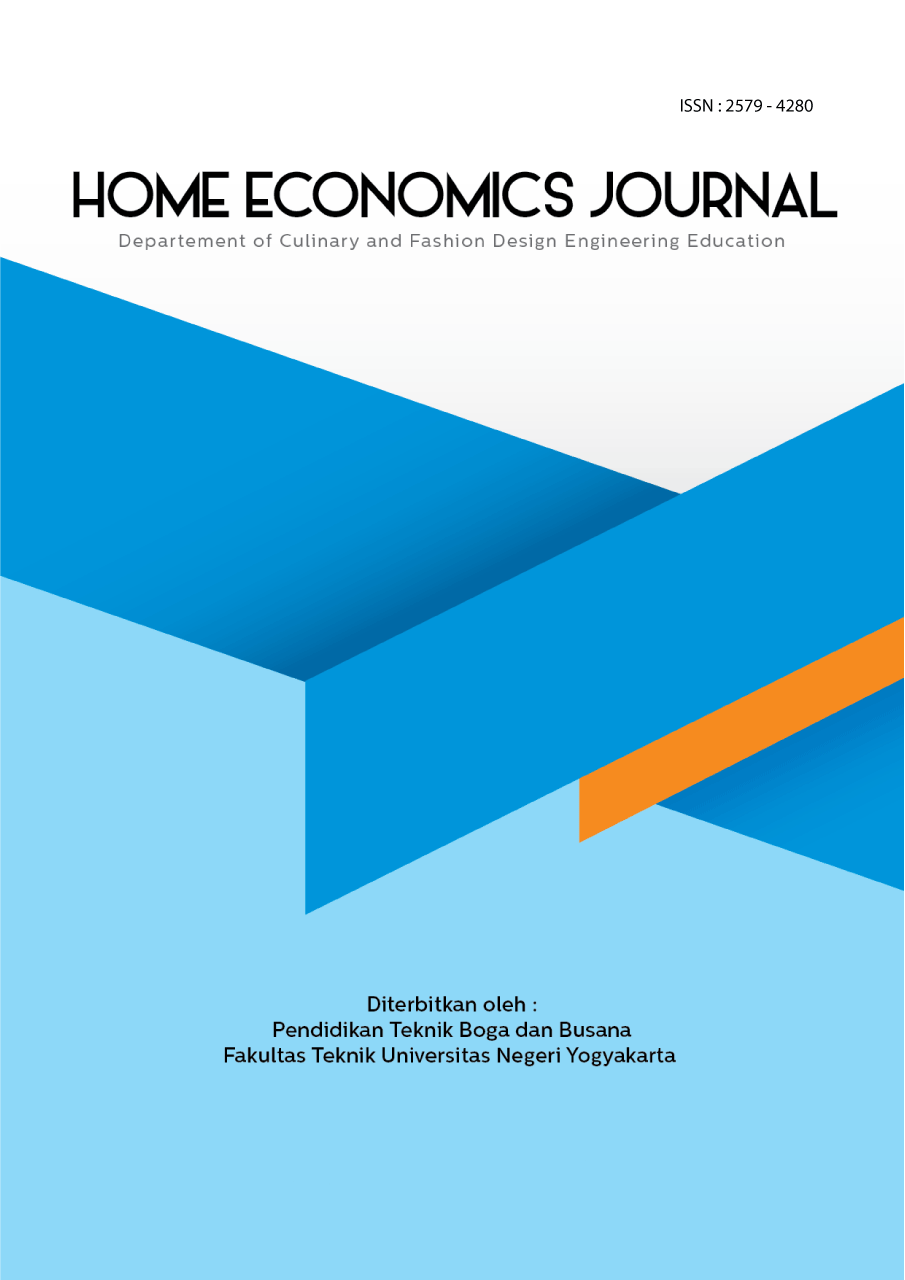BAMBU PETUNG AS INSPIRATION FOR MAKING CASUAL CLOTHES WITH A KIMONO SILHOUETTE
DOI:
https://doi.org/10.21831/hej.v9i1.77165Keywords:
Bambu Petung, Inspiration, Casual Clothes, KimonoAbstract
Batik is an ancestral cultural heritage that combines technology and art with a lengthy production process involving multiple stages. However, interest in classic batik among teenagers and women in their 20s has declined, as its motifs and colors are often perceived as outdated and unfashionable. This study aims to develop casual fashion designs inspired by bamboo to create modern batik motifs. Using a Research and Development (R&D) method, the study employed public response questionnaires to identify design preferences among young women. The results reveal a modern, fashionable, and aesthetically pleasing design that remains comfortable. The combination of kimono and culottes was found to enhance comfort and appeal. Expert evaluations yielded average scores of 47.5 for the motif, 48 for batik quality, and 32 for casual design. Meanwhile, responses from 51 participants indicated that the most appreciated aspects were motif elements, the meaning behind the motifs, and color combinations, followed by motif placement on casual fashion silhouettes and design details. These findings suggest that blending traditional elements (batik, kimono) with modern styles (culottes, casual fashion) is well-received by the target market in terms of both aesthetics and functionality. Future research should explore more diverse color combinations and garment details while maintaining the kimono-culotte concept to broaden the market reach.
References
[1] Y. Sunarya, Batik dalam Konteks Desain dan Kreatifitas Kini. 2013. doi: 10.13140/RG.2.1.2182.9366.
[2] S. Doellah, Batik Pengaruh Zaman dan Lingkungan. Surakarta. Danar Hadi, 2002.
[3] et al Ratna Saraswati, Pemanfaatan Daun Untuk Ecoprint Dalam Menunjang Pariwisata. Jakarta: Departemen Geografi FMIPA Universitas Indonesia, 2019.
[4] Sewan Susanto, The Art of Indonesian Batik Craft. Jakarta: Department of Industry Republic of Indonesia, 1980.
[5] M. Takdir and M. Hosnan, “Revitalisasi Kesenian Batik sebagai Destinasi Wisata Berbasis Budaya dan Agama: Peran Generasi Muda dalam Mempromosikan Kesenian Batik di Pamekasan Madura,” Mudra Jurnal Seni Budaya, vol. 36, pp. 366–374, Aug. 2021, doi: 10.31091/mudra.v36i3.1284.
[6] S. Hartanto, “Pewarnaan Alami dan Sintetis Limbah Sisik Ikan Sebagai Potensi Perhiasan/Aksesoris Mode,” Jurnal Da Moda, vol. 2, pp. 1–7, May 2021, doi: 10.35886/damoda.v2i2.173.
[7] Sugiyem, “Inovasi Produk Batik Untuk Pasar Global,” Prosiding PTBB FT UNY, vol. 9, no. 1, pp. 37–49, 2014.
[8] D. Sugiyono, Metode Penelitian Kuantitatif, Kualitatif, dan R&D. Bandung: Alfabeta Bandung, 2013.
[9] Irfantoni Listiyawan, “Ngelmu Pring, Makna Filosofis Pohon Bambu dalam Pandangan Hidup Orang Jawa,” 2017.
[10] Y. Sidiq and K. E. Mumpuni, “Identifikasi Variasi Genetik Parijoto ( Medinilla Javanensis ( Bl .) Bl . Dan Sumber Belajar,” Seminar Nasional XI Pendidikan Biologi FKIP UNS, pp. 667–672, 2014.
[11] Vina Mufti Azizah, “Semiotika Motif Batik Parang Rusak di Museum Batik Yogyakarta,” UIN Sunan Kalijaga., 2016.
[12] Y. P. Supriono, Ensiklopedia The Heritage Of Batik, Identitas Pemersatu Kebanggaan Bangsa. Yogyakarta: Andi Publisher, 2016.
[13] E. Krisnawati, N. Sunarni, L. M. Indrayani, A. N. Sofyan, and T. Nur, “Identity Exhibition in Batik Motifs of Ebeg and Pataruman,” SAGE Open, vol. 9, no. 2, 2019, doi: 10.1177/2158244019846686.
[14] Bernardo Palos, “The Role of Kimono in Modern Japanese Fashion,” The Palos Publishing Company. [Online]. Available: https://palospublishing.com/the-role-of-kimono-in-modern-japanese-fashion/
[15] W. Listianingrum and A. Hendrawan, “Eksplorasi Perintang Tekstil Dengan Inspirasi Visual Batik Remekan Pada Produk Fashion,” CORAK Jurnal Seni Kriya, vol. 9, no. 2, pp. 191–199, 2021, doi: 10.24821/corak.v9i2.4170.
[16] L. Sanjaya. F., & Yuwanto, “Budaya berbusana batik pada generasi muda,” Mediasi, vol. 5, no. 2, pp. 88-96., 2019.
[17] N. Butsainah, R.A.Putri, N. A. Zahra, Sugiyem, and L. K. Arifah, “Inspirasi Ragam Hias Candi Plaosan Dalam Karya Batik Tulis Sastra Menggala,” JADECS (Journal of Art, Design, Art Education & Culture Studies), vol. 9, no. 2, pp. 195–206, 2024, doi: http://dx.doi.org/10.17977/um037v9i22024p195-206.
[18] A. Kusrianto, Batik: Filosofi, Motif, Dan Kegunaan. Yogyakarta: Andi Publisher, 2013.
[19] D. H. Setiati, Membatik. Yogyakarta:KTSP, 2007.
[20] N. S. Djoemena, Batik: The Glory of Indonesian Culture. Jakarta: Gramedia Pustaka Utama, 2016.
[21] D. S. Kartika, Seni Rupa Modern dan Desain Kontemporer. Bandung: Rekayasa Sains, 2015.
[22] E. Tarlo, Visibly Muslim: Fashion, Politics, Faith. Berg Publishers, 2010.
Downloads
Published
How to Cite
Issue
Section
Citation Check
License
Copyright (c) 2025 Rifa Nur'aini, Sugiyem Sugiyem

This work is licensed under a Creative Commons Attribution-ShareAlike 4.0 International License.














